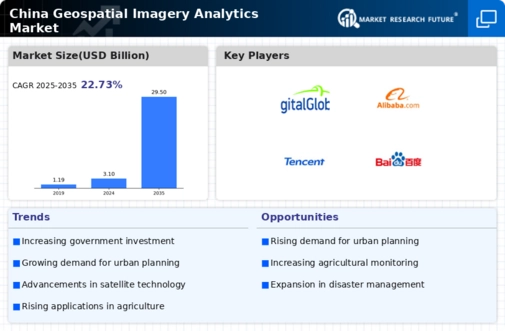Rising Urbanization
Rapid urbanization in China is a pivotal driver for the geospatial imagery-analytics market. As cities expand, the need for effective urban planning and management becomes increasingly critical. Geospatial imagery provides essential data for infrastructure development, land use planning, and environmental monitoring. According to recent statistics, urban areas in China are expected to house over 70% of the population by 2030, necessitating advanced analytics to manage urban growth. This trend indicates a growing reliance on geospatial technologies to address challenges such as traffic congestion, pollution, and resource allocation. Consequently, the geospatial imagery-analytics market is likely to experience substantial growth as municipalities seek innovative solutions to enhance urban living conditions.
Agricultural Optimization
In China, the agricultural sector is undergoing a transformation driven by the need for increased efficiency and productivity. The geospatial imagery-analytics market plays a crucial role in precision agriculture. It enables farmers to monitor crop health, optimize resource usage, and improve yield. With approximately 1.4 billion people to feed, the demand for advanced agricultural practices is paramount. The integration of geospatial data allows for real-time analysis of soil conditions, weather patterns, and crop performance. Reports suggest that the adoption of these technologies could enhance crop yields by up to 30%, thereby significantly impacting food security. As a result, the geospatial imagery-analytics market is poised for growth as stakeholders in agriculture increasingly leverage data-driven insights.
Infrastructure Development Projects
China's ambitious infrastructure development projects, including the Belt and Road Initiative, are driving demand for geospatial imagery-analytics. These projects require extensive planning, monitoring, and evaluation, which geospatial data can facilitate. The ability to analyze geographical information allows for better decision-making regarding transportation routes, resource allocation, and project feasibility. As investments in infrastructure continue to rise, the geospatial imagery-analytics market is likely to benefit from increased demand for data-driven insights. Reports indicate that infrastructure spending in China could reach over $1 trillion by 2030, highlighting the potential for growth in this sector. The integration of geospatial analytics into infrastructure projects may enhance efficiency and reduce costs.
Environmental Monitoring Initiatives
China's commitment to environmental sustainability is a significant driver for the geospatial imagery-analytics market. The government has implemented various initiatives aimed at monitoring and managing natural resources, pollution levels, and climate change impacts. Geospatial imagery provides critical data for assessing environmental conditions, enabling authorities to make informed decisions. For instance, satellite imagery is utilized to track deforestation, water quality, and urban heat islands. The market is expected to expand as organizations and government agencies increasingly rely on geospatial analytics to fulfill regulatory requirements and promote sustainable practices. This trend suggests a growing recognition of the importance of data in addressing environmental challenges.
Technological Integration in Smart Cities
The development of smart cities in China is a transformative trend. It significantly impacts the geospatial imagery-analytics market. As urban areas adopt smart technologies, the need for comprehensive data analysis becomes essential. Geospatial imagery serves as a foundation for various smart city applications, including traffic management, public safety, and energy efficiency. The integration of Internet of Things (IoT) devices with geospatial analytics enables real-time monitoring and data collection, enhancing urban management capabilities. With the Chinese government investing heavily in smart city initiatives, the market for geospatial imagery analytics is expected to grow. Projections suggest that smart city investments could exceed $500 billion by 2025, indicating a robust opportunity for geospatial analytics to play a pivotal role in urban development.















Leave a Comment